Vines serve many useful landscaping purposes. Where space is limited, vines may be used as dividers or barriers. They can screen unpleasant views or provide privacy for the patio or porch. The monotony of a long fence or blank wall may be broken with vines. They can soften harsh structural lines and blend the structure with other plantings. On steep banks and in other areas where grass is difficult to establish and maintain, vines may be used as groundcovers.
Selection
Selection of a suitable vine depends on its intended use, location, soil adaptability and type of support. Dense, coarse foliage is desirable if a screen is needed. A fine-textured, slow-growing vine should be selected to add pattern and interest to a stone or brick wall. A decorative vine should possess desirable flowers, fruit or foliage for seasonal interest.
Types
Vines are of three different types according to their method of climbing whether by tendrils, twining or clinging. The kind of support may be determined by the type of vine selected.
Tendrils are slim, flexible, leafless stems that wrap themselves around anything they contact (Figure 1). The grape is probably the best-known vine that climbs by means of tendrils. Twining vines wind their stems around any available support (Figure 2). Clinging vines climb by means of either tendrils with disk-like adhesive tips that attach themselves to any surface (Figure 3) or by means of small aerial rootlets along the stems that attach themselves into crevices of a rough-textured surface (Figure 4).
Vine supports
Twining and tendril-type vines climb best on wires, trellises, and arbors. They can be grown on flat surfaces only if proper supports are also provided.
Clinging vines can be used on either brick or masonry walls. They should never be used on the walls of buildings with wooden siding. These vines cling so closely to the wall that moisture is likely to collect under them and cause the wood to rot. Grow clinging vines on trellises far enough from the siding of wood structures to allow for free air circulation behind the vines. The trellis should be removable to permit painting the siding without damaging the vine.
Vine supports should be constructed with sturdy, durable materials. Wire, tubing or wood may be used to make suitable support. Copper or aluminum wire or tubing supports are preferred over other metals, because they will not rust. Redwood, cedar or cypress are the more durable woods for such structures. Structures made from treated lumber (e.g., ACQ) will also have a greatly increased life span.
Culture
Most vines grow best in a fertile, well-drained soil.
Plant bare-rooted vines in the spring before new growth starts. Plants produced in containers may be planted any time during the year.
Young vines should be trained to provide the desired growth pattern. New branches may need to be fastened into position by tying them with a soft cloth.
Some vines grow rampant and appear overgrown unless they are severely pruned at frequent intervals. Only when a naturalistic effect is desired and there is adequate space should vines be allowed to grow freely. Vines may develop sparse foliage low on the trellis and develop a mass of foliage at the top. To prevent this, pinch back the terminal growth of the stems as they develop. Pinching forces lower branching and more even distribution of foliage on the trellis.
Vines growing poorly should be fertilized in early spring. One cup of a 5-10-5 or similar analysis fertilizer should be worked into the soil around each vine.
Suggested vines for the Midwest
Bittersweet (Celastrus sp.)
 Figure 5
Figure 5
Bittersweet’s yellowish fruit capsules and scarlet-orange seeds provide added interest into late fall and winter.
There are two bittersweet types commonly grown for ornamental use in the garden: American bittersweet (Celastrus scandens) and Oriental bittersweet (Celastrus orbiculatus).
American bittersweet is a vigorous vine that grows 10 to 20 feet tall and climbs by means of twining stems. It will thrive in almost any soil or exposure except a wet, boggy situation.
Bittersweet is planted mainly for its attractive fruit, a favorite in dried arrangements. Reddish-yellow fruit capsules open in early autumn to expose red-orange berries. The fruits are grouped in terminal clusters, which make them conspicuous before the leaves fall.
Oriental bittersweet is similar to the American type but grows more vigorously. Vines often grow 30 to 40 feet tall. Fruit is similar in appearance but is borne in lateral clusters that are smaller than the American type. It is colorful as a garden plant, but the small clusters are less desirable for dried arrangements. Another type, the Chinese or Loesener bittersweet, is less hardy but grown because of its prolific fruiting habit.
Bittersweet produces male and female flowers on separate plants. Male and female plants must be grown to ensure fruit set. Male plants are more vigorous growers and usually must be pruned harder than female plants to prevent the berry-producing plants from being crowded out. One male plant should be used for five female plants.
Bittersweet is not easily transplanted due to the spreading root system. Thus small, young plants should be used. Plants grow rapidly once established and can become a nuisance if not pruned back occasionally to keep them under control. The vines should not be permitted to climb trees or shrubs as they have the ability to choke them out. Bittersweet occasionally may be infested with euonymus scale but has few other insect or disease pests.
Boston ivy or Japanese creeper (Parthenocissus tricuspidata)
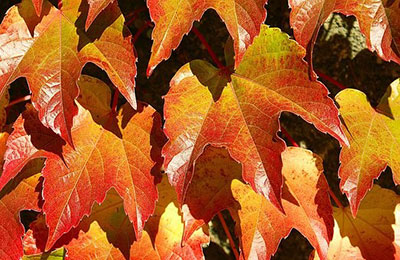 Figure 6
Figure 6
In addition to totally hiding a wall, leaves of Boston ivy provide dependable fall color.
Boston ivy or Japanese creeper is one of the best vines for covering large masonry buildings quickly. It is a fast-growing, close-clinging vine that climbs by means of adhesive disks.
The vine is tolerant to many soil types and grows in full sunlight or in shade.
Boston ivy grows to a height of 50 to 60 feet. Its green leaves stand out and overlap on long stalks. Leaves turn rich tones of scarlet, orange or purple in the fall. The new growth in spring is reddish bronze. The flowers are inconspicuous but attract a large number of bees. Fruit is fairly showy in the fall after the leaves are gone. The bluish-black berries are attached to the vine in grapelike clusters and persist after the leaves have fallen.
The vine is well adapted to city conditions. When given free rein, the vine will cover windows, doors, or other objects in its path. It requires annual pruning.
Boston ivy is easily transplanted. Start with 2-year-old plants.
Clematis
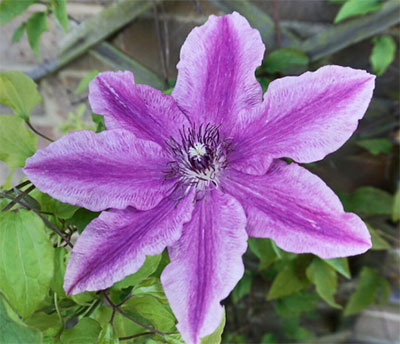 Figure 7
Figure 7
Hybrid clematis vines are light and airy with a profusion of spectacular flowers in white, blue, violet, purple, pink, red or bicolor, as shown here.
Clematis are among the most decorative and spectacular of all the flowering vines. A wide range of color and flower shapes may be found in the many varieties and species offered for sale.
The large-flowered clematis hybrids are the most widely used. These hybrids are deciduous vines that climb by twining stems, which act as tendrils (Figure 7). They attain a height of 8 to 10 feet. Flowering time varies according to variety but may be from late spring until frost.
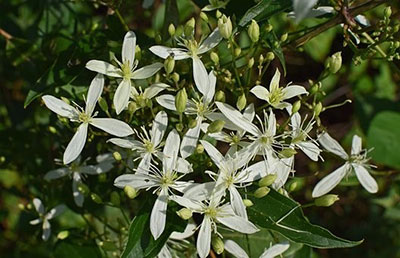 Figure 8
Figure 8
Although its flowers are small, few blooming landscape plants can match the delightful fragrance of Sweet Autumn clematis.
Sweet Autumn clematis, (Clematis terniflora), is a more vigorous species that grows to 20 to 30 feet. It is an easy vine to grow and is popular for the masses of very fragrant white flowers produced in late August and September.
All clematis prefer a light, loamy, well-drained soil with a pH between 6.5 and 7. Lime should be added if the soil pH is below pH 6.5. They require constant soil moisture.
Clematis grow well in full sun or partial shade. Preferably, the foliage should be exposed to full sun and the soil kept cool and shaded by low groundcover plants or mulch. Vines grow well on the east side of a wall but not on the north. Protection from strong winds is also desirable.
Proper pruning time depends on variety. Those that bloom on previous year's wood should be pruned immediately after flowering. Most types of clematis bloom on growth made during the current year and should be pruned in early spring before new growth starts. Pruning usually is not necessary during the first two years after planting.
When planting, the crown of the plant should be set 2 inches below the soil surface. Support, such as a bamboo stake, must be provided immediately to prevent breakage of the brittle stems. A light lattice trellis is one of the best supports for them.
The landscape uses of clematis are many. They are excellent accent vines when trained on arbors, light wire supports or delicate trellises, but are also effective when allowed to trail over rocks, stone walls, or fences.
English ivy (Hedera helix)
 Figure 9
Figure 9
English ivy is a handsome evergreen vine that climbs by attaching itself to rough surfaces with very short aerial rootlets.
The rich, leathery, dark shiny leaves of English ivy hold their color all winter if protected from winter sun and wind. North- or east-facing walls are the most satisfactory locations.
English ivy prefers a shady location with a fairly moist soil well supplied with organic matter.
The flowers are greenish and small followed by 1/4-inch, blue-black fruit in large clusters that persist for several months. They are only produced, however, on old vines that have reached maturity.
The landscape uses of English ivy are many, both indoors and outdoors. As a groundcover in the shade or under trees and shrubs, it is an excellent broadleaved evergreen. Interesting patterns are formed on vertical, flat masonry or brick surfaces during its first few years of growth. It is not suitable for covering walls with a southern exposure because of the intense summer heat and winter sun.
Several English ivy varieties have shown greater winter hardiness and less browning in our climate. The best of the winter-durable varieties includes 'Baltica,' 'Bulgaria' and 'Thorndale.'
Honeysuckle (Lonicera sp.)
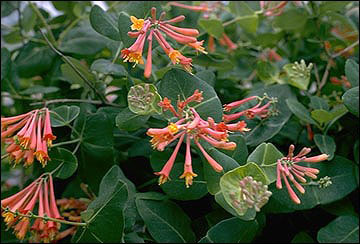 Figure 10
Figure 10
Scarlet trumpet honeysuckle produces red flowers early in the spring and again throughout the summer. It is a favorite of hummingbirds.
Only a few honeysuckles are suitable for landscape use. Once popular, Hall’s Japanese honeysuckle (Lonicera japonica 'Halliana') is now considered invasive and not an appropriate choice for landscape plantings.
Suitable non-invasive alternatives to Japanese honeysuckle includes Scarlet trumpet honeysuckle (Lonicera semperivirens), Everblooming honeysuckle (Lonicera x heckrotti), and Perfoliate honeysuckle (Lonicera caprifolium).
Scarlet trumpet honeysuckle is a loose-growing vine with twining stems and semievergreen bluish-green leaves (Figure 10). Trumpet-shaped flowers scarlet in color are produced from May to August at the ends of the branches. A yellow-flowered form is also available. Red fruit attract the birds in early fall. It will grow 15 to 20 feet high.
Everblooming honeysuckle is a semi-shrubby vine that climbs up to 15 feet by twining. It is somewhat spreading with blue-green leaves and bright carmine flower buds that open to show deep yellow inside the trumpet. It is slow growing and can either be grown on a trellis or trained as a shrub. Its flowers are produced from June until September.
Perfoliate honeysuckle has oval to elliptic leaves that are bluish beneath. In midsummer, it bears very fragrant, cream-colored flowers that are tinged with pink. It is less common than the other types listed here, but along with Tellmann’s honeysuckle, it is suitable for landscape use, when available.
Honeysuckles are among the easiest plants to grow in the garden. They will thrive in either sun or shade. Although they perform best in good garden soil, they will tolerate poor soils. Well-drained soils are best, however, as they do not tolerate wet, boggy conditions.
Honeysuckles stand severe pruning and can be cut back to 6 to 8 inches if they have grown out of bounds or need rejuvenation.
Although a few insects and diseases may attack honeysuckles, they usually are not serious problems.
Kiwi, hardy (Actinidia arguta)
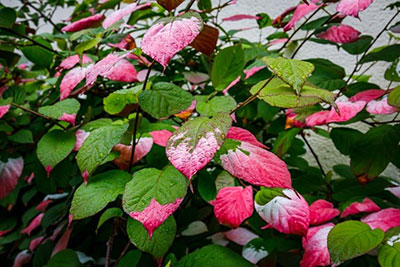 Figure 11
Figure 11
Bearing leaves that are variegated with pink and cream, ‘Arctic Beauty’ is one of the more colorful cultivars of hardy kiwi.
Hardy kiwis recently have gained popularity as both ornamental vines and fruiting vines. Hardy kiwis are not the same species of kiwi that produces the fuzzy brown fruit available in grocery stores. The fruit of hardy kiwi is smaller and smooth-skinned.
Kiwis are vigorous vines that will need strong support. Once vines are established, they may grow as much as 20 feet a year. A fairly high trellis is needed to support them, usually very wide and up to 6 or 7 feet so fruit can be picked easily. They will grow well in both heavy and light soils, but need irrigation during hot, dry weather. A windbreak will provide them with protection from winter damage if conditions become particularly severe. They leaf out very early in the spring, so both flower buds and young shoots are subject to spring frosts.
The species most likely to produce fruit in our climate is Actinidia arguta. The variety 'Ananasnaja' has the largest fruit of any of this species, and it is very sweet. The name is Russian and means "pineapple-like." Kiwis are dioicous meaning there are both male and female plants. Thus, they are often sold in quantities of three, one male and two females, to ensure pollination. 'Issai,' a newer variety from Japan, is self-fruitful so the home gardener with only space for one vine might want to try it. 'Issai' is also a smaller, more compact vine than other kiwis.
Most ornamental of the kiwis is 'Artic Beauty' (Figure 11) which is a variety of the species Actinidia kolomikta. Fruits are smaller, the size of a large grape, but the leaves contain pink and white variegation. Males are more colorful than females, but it may take several years and maturity of the vines before they begin to produce colorful leaves. This species flowers earlier than the others, so do not expect to use it as a pollinator for other species.
Kiwis are a new plant for the Midwest, and much still needs to be learned about growing them. It currently appears that their value as vines for ornamental purposes and screening outweighs their dependability for fruit production, because of their early growth during times when spring frosts are still frequent.
Silver fleece flower (Fallopia aubertii)
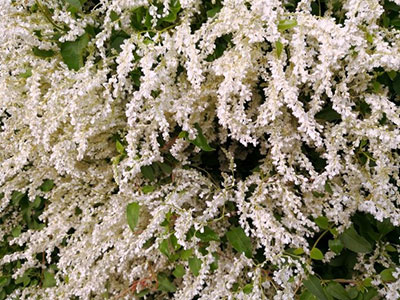 Figure 12
Figure 12
Silver fleece flower derives it common name from its clusters of small, white flowers borne in late summer.
This vine, which is sometimes called silver-lace vine, produces clusters of small white to greenish-white flowers in August and September. The small white flowers turn pinkish at maturity and remain effective for a long time.
The vine is a rank grower and suitable for city conditions. It is adaptable to many soil types but needs a sunny location.
Silver fleece flower can be used for a quick screen and, once established, may grow as much as 20 feet in a single season. The foliage is dense and bright green. It will require severe pruning each spring to keep it within bounds.
Trumpet creeper (Campsis radicans)
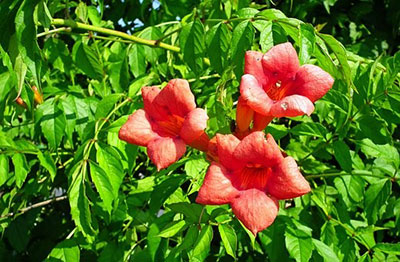 Figure 13
Figure 13
Colorful and easy to grow, trumpet creeper blooms best in full sun and adapts to a variety of soil or moisture conditions.
Common trumpet creeper is a deciduous, robust vine that climbs by both aerial rootlets and twining stems. Growing to a height of 25 to 30 feet, this vine is useful for rustic effects on fence posts, walls, poles or rockwork.
Brilliant orange and scarlet, 2-1/2 to 3-1/2 inches long, trumpet-shaped flowers are very showy from July through September (Figure 13). The dark green leaves present a bold, tropical appearance. Long cigarlike fruits on bright tan stems may be considered decorative during the winter months. Common trumpet creeper grows well in partial shade. However, a full sun exposure is required for maximum flower production. It will tolerate both wet and dry soils.
Additional support is sometimes required for this vigorous vine. Tying the heavy branches to a sturdy support and thinning the vine in early spring will prevent strong winds from tearing it down. Pinch back the tips during the growing season to eliminate excessive top growth and promote business.
Common trumpet creeper transplants readily. It is a prolific seed producer and may become a pest if not kept under control. A hybrid variety, 'Madame Galen,' has larger, more showy flowers than the common type. Flower color is salmon red rather than orange-scarlet.
Virginia creeper or Woodbine (Parthenocissus quinquefolia)
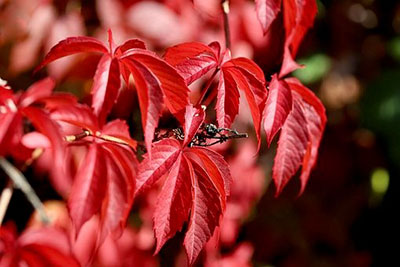 Figure 14
Figure 14
Leaves of Virginia creeper produce beautiful red fall color and are some of the first woody plants to turn color in the fall.
Virginia creeper is a native, deciduous vine that climbs both by means of tendrils with adhesive disks which adhere to brick, stone or tree trunks, and by aerial rootlets which attach only to rough surfaces. It grows 30 to 50 feet tall and has a loose, open growth pattern.
The leaves of Virginia creeper are five-parted and stand out on slender, drooping side branches. They open as a purplish color in the spring, remain dull, deep green throughout the summer and turn brilliant scarlet or crimson before dropping in the fall months.
Virginia creeper is one of the first of all woody plants to display fall color. Its conspicuous greenish flowers develop into clusters of bluish-black, pea-sized berries in September and October. The berries either fall before winter or are eaten by birds after the leaves drop.
Virginia creeper will grow in a variety of soils. It is considered to be a very drought-resistant plant. It will thrive in either a sunny or shady exposure.
Virginia creeper is valued for producing a pleasing pattern on large blank walls, for covering rustic structures and for covering ground or bank in rocky areas.
Wisteria (Wisteria sp.)
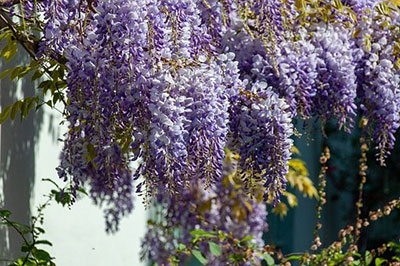 Figure 15
Figure 15
Both Chinese and Japanese wisteria need space and large supports.
The wisteria are vigorous twining vines that grow to 25 or 30 feet (Figure 15). These vines are most valued for their long, pendant clusters of violet-blue flowers. Varieties are available that produce flowers of varying colors (from white to pink to deep reddish and bluish-violet). Beanlike velvety pods remain after the leaves fall but are not particularly ornamental.
All wisterias will bloom, but some vines take as long as 7 to 15 years to produce their first flowers. Excessive nitrogen fertilizer may stimulate leaf and stem growth at the expense of flower production.
The following practices may help induce flowering:
- An application of superphosphate in early spring
- Severe pruning of the new growth in late spring or early summer
- Root pruning by cutting some of the roots with a spade a few feet from the trunk in late fall.
Grafted plants or plants that have flowered in the nursery are recommended.
Wisterias are excellent for training on stoutly constructed arbors and pergolas. They are best when trained horizontally on a wire or structure 10 to 20 feet above the ground. The vines are excellent for use on open-structured roofs over patios and terraces. Do not plant too closely to trees or shrubs as it will choke them out.
Wisterias sometimes are grown as standards or trees. The plant must be staked in an upright position with the branches removed 4 to 5 feet up the stem and the top pruned heavily.
A vigorous, flowering vine may be maintained by pruning back long branches to within five buds from their point of origin in early summer. Repeat this pruning in late summer on new shoots that develop. Remove all thin and weak growth immediately after flowering or in late winter.
Wisterias prefer a deep, rich, moist, well-drained soil high in organic matter. A sunny location will favor maximum flower production.
Missouri gardeners may choose from two different species:
Japanese wisteria (Wisteria floribunda) is a rapid-growing vine. It climbs by stems twining from right to left. A twisted, heavy main stem or trunk several inches in diameter is often developed. The shiny, bright green leaves are arranged in clusters 8 to 36 inches long. The flowers open gradually from the base to the tip of the cluster when the leaves appear. The flower clusters are longer but are more open than those of the Chinese wisteria (Wisteria sinensis).
Chinese wisteria is a more vigorous grower than the Japanese wisteria but stems twine from left to right. This is the type most commonly grown in gardens. The flowers appear before the leaves and are slightly fragrant. All flowers on the cluster open at the same time, a better display than the Japanese wisteria. Both violet-blue and white forms are available.
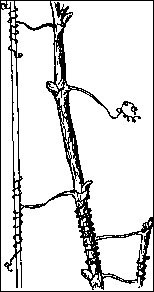 Figure 1
Figure 1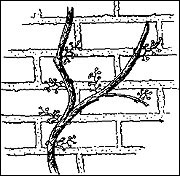 Figure 3
Figure 3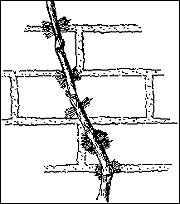 Figure 4
Figure 4